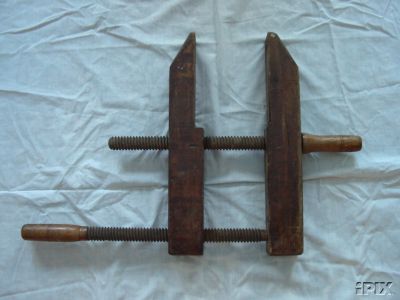 The identification as Denney is based on the
maker's mark.
The identification as Denney is based on the
maker's mark.Top Page > Clamps as Products > Makers of Wooden Clamps (WC) > Denney
Table of Contents
I know that a catalog dated 1892 exists. The owner did not care to share the contents.
Lloyd Henley was kind enough to lend me an example, with 12 inch jaws, from his collection. Since that time, I have acquired my own example, with 18 inch jaws.
 The identification as Denney is based on the
maker's mark.
The identification as Denney is based on the
maker's mark.
This example is my own. The jaws have been mutilated, so that the swivel pad is much reduced in size.
The workmanship of Denney clamps is not as good as that of some other makers. Circular scratches can be found on the top and bottom sides of the jaws. In addition, the ends of the jaws are not sanded smooth, but have ridges from the annual growth rings. The marks of the planer are left on the adjustable bearing piece. The marks of the lathe are left in the handles.
John Adams has commented to me that he wished Denney had sanded the jaws better, so that the mark is more visible.
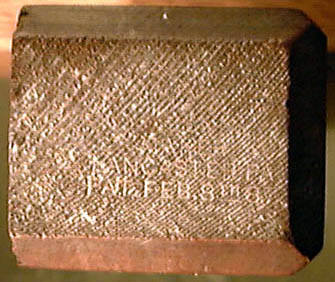 This mark (Henley's example) is exceptionally
faint, and struck with more force on the bottom line than the top.
The result is that the mark is:
This mark (Henley's example) is exceptionally
faint, and struck with more force on the bottom line than the top.
The result is that the mark is:
illegible
MAKER
LANCASTER PA
Pat'd Feb 8th '87
(To guide the viewer, in MAKER, the M is over the C, the K is over
the ST, and the R is over the ER. I will try again to improve the
lighting, so that there are no shadows from the ridges, only from the
mark.)
Notice the pronounced chamfering, giving this an almost faceted
look.
I hope to replace this with an image of my example, which is
marginally better.
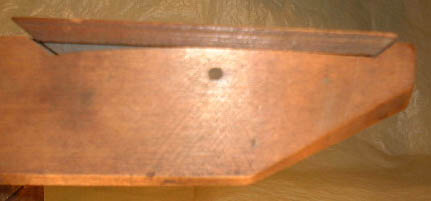 The stopped jaw has an adjustable piece, held in
place by a metal pin. The details do not agree with the patent
drawing in every particular, but it is clear that this follows the
Denney patent of 1887.
The stopped jaw has an adjustable piece, held in
place by a metal pin. The details do not agree with the patent
drawing in every particular, but it is clear that this follows the
Denney patent of 1887.
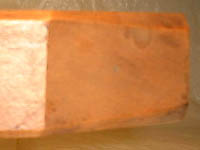 A distinctive characteristic is the flare of the
chamfer down the slope, widening as it goes, in contrast to Bliss
which narrows as it goes.
A distinctive characteristic is the flare of the
chamfer down the slope, widening as it goes, in contrast to Bliss
which narrows as it goes.
The threads are hand cut.
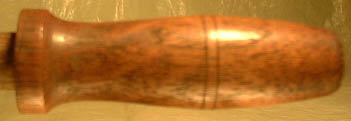 The through handle is deeply waisted, with a
pronounced cylindrical bearing shoulder. It is decorated with two
lines at the greatest diameter, not quite half way along.
The through handle is deeply waisted, with a
pronounced cylindrical bearing shoulder. It is decorated with two
lines at the greatest diameter, not quite half way along.
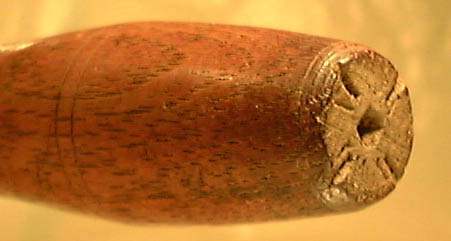 The lathe mark in the handle end has four prominent
indentations, evenly spaced, and five minor indentations unevenly
spaced.
The lathe mark in the handle end has four prominent
indentations, evenly spaced, and five minor indentations unevenly
spaced.
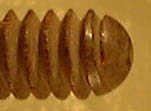 The end of the through spindle is hemisperical, but
with a pronounced central pit from the lathe.
The end of the through spindle is hemisperical, but
with a pronounced central pit from the lathe.  The stopped handle is somewhat barrel shaped, with
the greatest diameter about two thirds of the way along. It is
decorated with two lines, about half way along.
The stopped handle is somewhat barrel shaped, with
the greatest diameter about two thirds of the way along. It is
decorated with two lines, about half way along.
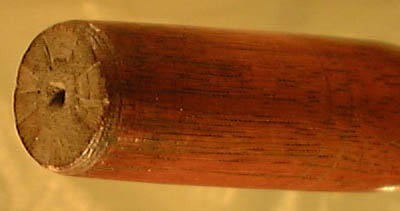 The lathe mark in the handle end has four broad and
shallow indentations with ribbing, evenly spaced, and several other
indentations, unevenly spaced.
The lathe mark in the handle end has four broad and
shallow indentations with ribbing, evenly spaced, and several other
indentations, unevenly spaced.
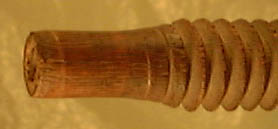 The stub end of the stopped spindle is cylindrical,
with flat face, and a pronounced central pit from the lathe.
The stub end of the stopped spindle is cylindrical,
with flat face, and a pronounced central pit from the lathe. Can anybody interpret the lathe markings? Can they identify the lathe used to form the handles?
last revised and validated
Copyright © 1996- Wooden Clamp Journal